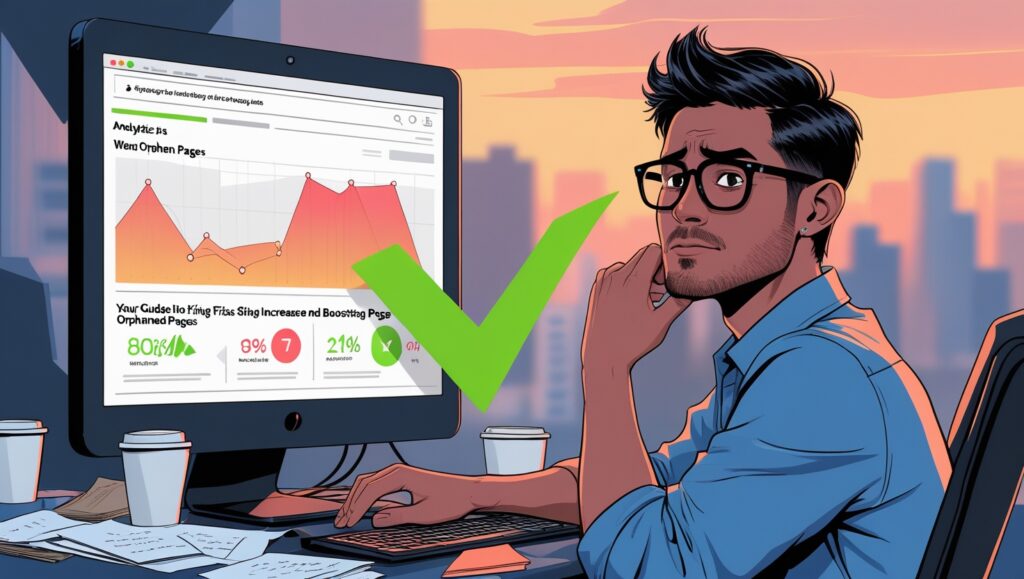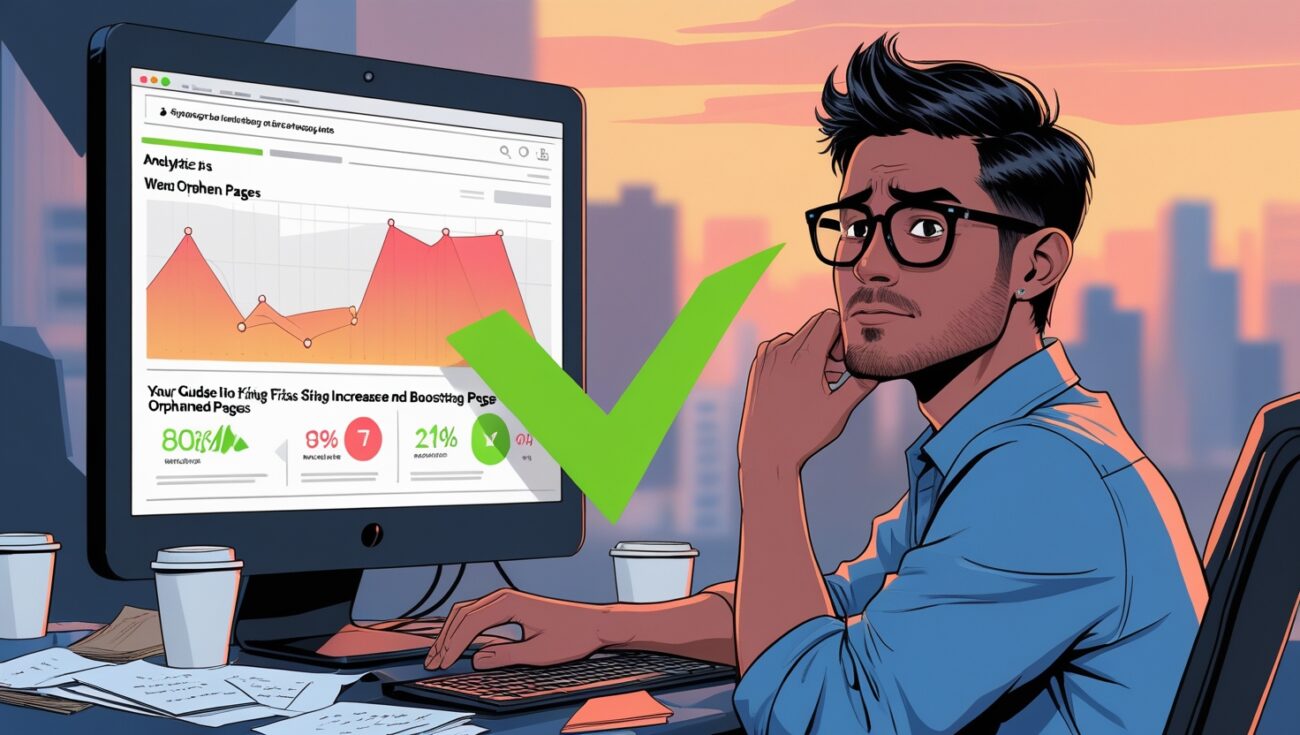Your Guide to Fixing Orphaned Pages and Boosting Site Visibility
I’ve learned that a website can be full of valuable content, but if no one can find it, it’s virtually useless. This is the problem of the orphaned page. Imagine creating a brilliant article, a perfect product description, or an insightful guide—but then hiding it in a corner of your website where no one can navigate to it. That page is an orphan, and it’s a silent SEO killer that plagues countless websites.

Table of Contents
An orphaned page is a serious problem because it can’t be discovered by search engines, it can’t receive any valuable link equity, and it can’t be found by your users. It’s a waste of your time and effort. The good news is, finding and fixing these invisible pages is a straightforward process, and with the right tools, it’s easier than you might think. Let me walk you through my complete guide to a healthier, more visible website.
What Exactly is an Orphaned Page?
An orphaned page is a page on your website that has no incoming internal links from other pages on your site. While a user might still be able to find it if you share the URL on social media or if it’s already indexed by Google, it is disconnected from your site’s main architecture and its internal link profile.
This disconnection is a major issue because it makes the page fundamentally invisible to search engine crawlers that navigate your site by following links. If a bot can’t find the page, it can’t index it. If it can’t index it, it won’t rank.
The Silent SEO Killer: Why Orphaned Pages Are a Big Problem
- Crawlability Issues: Search engine crawlers navigate your website by following your internal links. If a page has no incoming links, the crawler has no clear path to discover it. This often results in the page not being indexed, meaning it will never show up in search results.
- Wasted Link Equity: Every internal link you create is a vote of confidence, passing valuable link equity from one page to another. An orphaned page receives no such votes. It’s an island, starved of the authority it needs to rank well.
- Wasted Content & Poor User Experience: The time and effort you put into creating an orphaned page are essentially wasted. A user who would find the content valuable can’t get to it from your main navigation or from your related articles. This is a frustration for them and a lost opportunity for you.
Your Step-by-Step Guide to Finding and Fixing Orphaned Pages
Step 1: The Audit: How to Find Your Orphaned Pages
The first and most important step is to identify all of your orphaned pages. You can’t simply find them manually. You need a tool that can crawl your entire website, map out your internal link structure, and then identify any pages that are disconnected. A comprehensive SEO tool is essential for this. I highly recommend using a tool like Linkbot to perform this critical audit and uncover all of your orphaned pages.
Step 2: The Action Plan: How to Rescue Your Pages
Once your tool has finished its crawl, you’ll have a list of all your orphaned pages. You now have a few options for each one:
- Option A: Link to it from a High-Authority Page. The best solution for a valuable orphaned page is to link to it from a relevant, high-authority page on your site. This not only makes the page discoverable but also passes valuable link equity to it, giving it a much-needed SEO boost.
- Option B: Delete the Page. If the orphaned content is outdated, low-quality, or no longer relevant, it’s probably best to delete it to keep your site clean.
- Option C: Implement a 301 Redirect. If you want to keep the content’s value but have a more relevant page that addresses the same topic, a 301 redirect from the orphaned page to the new one can consolidate your authority.
The Role of Automation in Preventing Orphaned Pages
Orphaned pages aren’t a one-time problem. They will appear over time as you add, remove, and update content. That’s why a proactive approach is the best long-term strategy. Automated internal linking software can continuously monitor your website, alerting you to new orphaned pages as they appear. It’s an essential piece of ongoing SEO maintenance that ensures your hard work doesn’t go to waste. With Linkbot, you can automate this crucial part of your SEO and keep your site healthy.
Conclusion: Take Control of Your Site’s Visibility
Orphaned pages are a silent killer of your site’s SEO. They waste valuable time and effort, harm crawlability, and prevent your content from receiving the link equity it needs to rank. By taking a proactive approach to finding and fixing them, you can significantly improve your website’s health and visibility.
Don’t let your valuable content sit in the shadows. Take control of your site’s SEO and ensure every article you’ve worked so hard on is contributing to your site’s overall authority. Start your journey to a healthier website with Linkbot today.
Beyond the technical side, a collection of orphaned pages is a clear signal of poor user experience. When a visitor stumbles upon a page that isn’t connected to your main website, it creates a sense of a disorganized and unprofessional operation. A clean, well-maintained site that provides a smooth user journey from one page to another is crucial for building trust and contributing to the “Experience” part of your E-E-A-T score.
A consistent effort to fix orphaned pages also builds your site’s overall trustworthiness and authority. A website riddled with disconnected content looks unprofessional and signals to search engines that the site may not be well-maintained. A clean link profile, on the other hand, is a clear sign of quality that Google will reward with higher rankings.
By fixing orphaned pages, you are directly helping a search engine’s ability to crawl your website. A bot follows links from page to page, and a disconnected page is an invisible piece of content that wastes your limited crawl budget. When you bring that page into your internal link structure, you are making it easier for the bot to discover and index more of your valuable content.
The process of fixing orphaned pages is a foundational part of a larger internal linking strategy. You can’t effectively pass link equity or build a strong site hierarchy if parts of your network are completely disconnected. It’s a prerequisite to any advanced SEO tactic, and it’s the first place I look when diagnosing a site’s health.
For any business owner or blogger, finding the time for a regular site audit can be a challenge. That’s why establishing a schedule is key. I personally aim for a full orphaned page check at least once a month, or after any major content update. This proactive approach prevents small errors from becoming major problems.
One of the greatest benefits of using an automated tool for your audit is the “to-do” list it provides. Instead of being overwhelmed by a massive report, a good tool will give you an actionable list of orphaned pages to fix. It transforms a daunting task into a series of manageable steps that you can tackle in minutes.
The long-term ROI of a consistent orphaned page maintenance plan is undeniable. It’s a foundational SEO task that you have full control over, and the benefits—from improved rankings and traffic to a better user experience—are long-lasting and continue to grow over time. The time invested is paid back many times over.
I can say from personal experience that making this one change—from ignoring dead links and orphaned pages to actively monitoring them—has been one of the most impactful changes I‘ve made to my website. It’s transformed my SEO efforts from a passive hope into a proactive strategy that gives me a real sense of control over my site’s destiny.
Beyond just fixing the page, a well-designed custom “404 Not Found” page can help mitigate some of the damage if a user accidentally lands on a page that was orphaned or deleted. By providing a friendly message and a clear path back to your most important content, you can turn a user’s frustration into a a positive experience, and guide them back to a relevant page.
By linking an orphaned page back into your site structure, you are not only making it visible but also helping it rank for a variety of long-tail keywords. The new internal link from a relevant, authoritative page gives the orphaned page the topical relevance and authority it needs to begin competing for a wider variety of search queries.
The compounding effect of a consistent maintenance strategy is what truly makes it a hero. Each time you find and fix an orphaned page, you’re making your entire website more authoritative and resilient. The small improvements you make on a regular basis add up to a significant SEO advantage over the long term.
Ultimately, fixing orphaned pages is not just about correcting errors; it’s about building a trustworthy, high-quality website. It’s the difference between a site that works for you and one that works against you, a foundational task that every blogger and business owner should prioritize.

